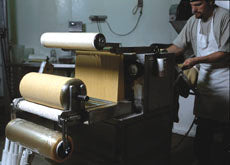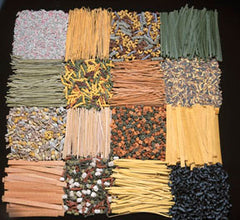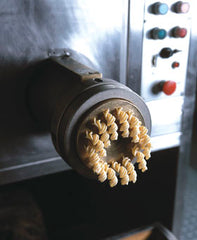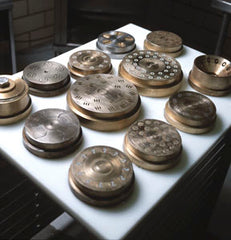Your Cart is Empty
*FREE DRY SHIPPING ON ORDERS OF 9+ DRY PRODUCTS*
The relentless pursuit of perfect pasta!
David Bowen and Bill Curtis founded Pappardelle’s in Denver on May 14, 1984. Their vision? Exquisite, fresh pasta in an array of flavors never before experienced by Americans. At that time, pasta in the United States was generally limited to the one basic flavor: plain.
After extensive research they decided that the only way to ensure that their pasta creations would be of the highest quality was to recreate the traditional Italian pasta making methods: fresh, high-quality ingredients and small batches. And, because they lacked production equipment of any size, the early batches were almost entirely made by hand. They started with just these six flavors: egg, spinach, cracked pepper, garlic parsley, lemon pepper and tomato basil. They arrived for work each day at 3 a.m. to have enough time to create orders for fresh-flavored pastas to be delivered that same day in Bill’s 1976 beat-up red Chevy Malibu.

This worked (it was also very tiring!) and the business started to grow. In 1986, Bill and David decided it was time to invest in their first “big” dough machine. And so off Bill went to Italy, with $10,000 cash in his briefcase. He returned with two 25 pound Pama Roma machines — tiny by even our small company standards today, but back then it was quite an advancement over rolling and cutting the pasta by hand. Like the finest pasta makers, David and Bill used bronze dies to form the pasta, which produces a coarser noodle that holds its sauce and feels luxurious on the palate. Pappardelle’s was adhering to “Slow Food” principles such as preserving traditional methods of food preparation and using only the highest quality ingredients, long before it was the “in” thing.
As more chefs realized they could get very high quality pasta in small batches and in flavors never before imagined, the company’s requests for more flavors expanded (and so, of course, did its recipe collection). The company quickly developed a strong local reputation for quality, innovation and customer service. Word spread quickly through the gourmet world and they soon started to hear from chefs across the country who were intrigued by this little Denver pasta purveyor with its unique pasta assortment.
Part of the success of the company can certainly be attributed to the mantra employed by the founders, “Never say no!” This way of doing business increased sales and expanded the number of varieties of pasta exponentially.
An example of their can-do spirit is a wonderful story of how Pappardelle’s got started making ravioli. The chef at Cheyenne Mountain Resort near Colorado Springs asked if Pappardelle’s had a chocolate dessert ravioli. Without missing a beat, Bill said “Sure, how many and when do you want them?”
“It’s for a wedding next week,” the chef replied. “I’ll take 3,500 ravioli pieces.”
As one would imagine, David wanted to strangle Bill when he heard the request. They had never before made ravioli for any of their restaurants, had no chocolate dessert ravioli recipe and had no special equipment for making ravioli in that quantity. With the use of lots of rolling pins and hand held pastry fillers, the help of David’s mom and dad (who, by the way, had also provided Bill and David with their seed money to start their little deli and pasta business), and several sleepless nights, Bill proudly fulfilled their first ravioli order that next week. The chef and wedding guests were delighted and a new chapter began for Pappardelle’s. Soon after, they decided to purchase Italian dough and ravioli machines and began creating other ravioli.

In 1991, we began drying our fresh flavored pastas, preserving the traditional Italian methods of slow-drying pasta at temperatures well below mass-produced pastas. David learned about the art of drying pasta from a friend who was selling a few of his own flavored dried pastas at a local farmers’ market in Cherry Creek, Denver, which at the time was a new and relatively small farmers’ market. Pappardelle’s started making dried pastas for this farmers’ market vendor, but he soon left the farmers’ market and stopped selling pasta altogether. Bill approached a local bread vendor at the market about picking up Pappardelle’s newer line of flavored dried pastas. They agreed, and so began Pappardelle’s entrée into its special farmers’ market niche.
While we have grown to over 200 farmers’ markets around the nation and spawned a slew of imitators who have tried to copy many of our original flavored pasta creations, Pappardelle’s primary business still traces its roots to “white tablecloth” restaurants and upscale hotels and resorts. For example, we have been offered across the country in well-known places such as:
The Breakers Palm | Beach, Florida
The Williamsburg Inn | Williamsburg, Virginia
Hotel Monteleone | New Orleans, Louisiana
The Biltmore | Phoenix, Arizona
The Brown Palace | Denver, Colorado
The BroAdmoor | Colorado Springs, Colorado
Beaver Creek Lodge | Beaver Creek, Colorado
Hotel Jerome | Aspen, Colorado
The Coronado | San Diego, California
The Lodge at Rancho Mirage | Racho Mirage, California
In addition, our lobster ravioli was served during a State Dinner at the White House in the early 1990’s. And over the years we have been a “regular” on the table at the Colorado Governor’s Mansion.
But it was probably in August 1993 that we were honored to have the most dignified person enjoy our pasta. One day at the new plant, a black sedan drives up and out jump four suited, sunglass-bearing enforcer-looking gentlemen. They announced they were with the Secret Service and were there on behalf of the Archdiocese. They asked how our fresh pasta was made and insisted on inspecting the manufacturing area. We showed them around and apparently they were satisfied because they promptly ordered 20 pounds of fresh egg fettuccine. The agents selected the fresh roll of pasta, stationed themselves at strategic locations in our plant and personally accompanied the pasta as it was removed from the walk-in refrigerator, cut and placed in boxes. The recipient? The Pope. He was in town for Denver’s World Youth Day. He wanted fresh pasta and Pappardelle’s is where they came!

Fast forward to the present, after 18 years of building their little pasta idea into Pappardelle’s, David and Bill needed a change. And so did Pappardelle’s. It was time for a fresh perspective. Jim and Paula bought Pappardelle’s in April, 2002. Coming off of 9/11, it was a tough business climate for Pappardelle’s as tourism, the economy and dining out came to a virtual standstill.
But Jim and Paula believed so strongly in David’s myriad of creations and in Bill’s success in establishing a stellar reputation for Pappardelle’s that they had no doubt that the company would continue to succeed. Some of the things Jim has added include the following:
After over 15 years at the helm, Jim's vision has not changed since the first day he took over. Pappardelle’s remains committed to its core values of small carefully monitored batches using time-tested traditional Italian production techniques, unique international flavor infusion, and top quality all-natural ingredients -- resulting in intense flavors, aromas and colors that retain their vibrancy through the cooking process. We want to continue being the pasta manufacturer of choice for executive chefs at white table cloth restaurants, caterers, hotels and resorts. We want to ensure our customers continue to enjoy their “Pappardelle” experience through our ambassadors who represent us at farmers’ markets and at specialty gourmet stores and through our delivery of customer service for those who buy directly from us. And we want to continue to be a place where employees are proud to work and to say they are an integral part of bringing you the best pasta made in the United States.
In 2003, we adopted the tagline: Pappardelle’s Pasta -- The Fine Art of Pasta.
Why? Pasta as art? Indeed! Our pasta is produced with the same care and attention to detail that artists use when taking paint to canvas or chisel to stone. Pappardelle’s pasta is a true artisanal food.

And what exactly is an artisanal food? It is made by hand, using the finest-quality ingredients available and following traditional methods of production.
Our pasta makers have an intimate knowledge of every step of the time-honored tradition of making pasta: the flour, the added ingredients, the mixing and extruding, and finally, the drying process. Every one of our products has the touch and oversight of a pasta maker guiding it through the delicate craft of turning flour, water and a variety of herbs, spices, vegetables and fruits into edible art — it takes one of our pasta makers well over a year to hone his or her skills and become a master dough maker. Even members of our packaging team must be carefully trained to assess quality and to handle our products delicately, as theirs is the last touch and chance to make sure every thing is perfect.
If pasta is essentially just flour and water, what could possibly set Pappardelle’s apart from the hundreds of varieties available today? To begin with, the quality of the flour is integral to the final product.
Although flour is made out of wheat, it can vary wildly -- not only nutritional content, but also flavor and overall integrity. Pasta made with all-purpose or bleached flours are inferior. Pasta made with a combination of all-purpose flour and semolina durum wheat are only slightly better. Only pure durum semolina flour gives birth to high-quality pasta. So, of course, this is the type of flour that Pappardelle’s uses in all of its pasta.
The majority of durum semolina flour used by the pasta industry in this country is grown in the northern part of the United States. Cool summer nights and long, warm summer days create ideal conditions for durum to thrive. Durum is planted in mid-April and harvested in late August. Semolina is the coarsely ground endosperm of durum wheat that's golden in color and very coarse and granular in texture.
We at Pappardelle’s know that the better the durum, the better the pasta. It is from durum wheat, the hardest wheat known, that pasta gets its yellow amber color, pleasant nutty flavor and the ability to retain both shape and firmness when cooked. We have been sourcing our flour from the same supplier since our birth in 1984, ensuring the best and most consistent pasta quality available to you.

Pasta is sturdy, but during production it can be temperamental — a host of factors can ruin a batch of dough. For example, our process must take into account the nature and moisture level of each raw ingredient, how much water is added during the mixing process and exactly what temperature water is ideal for the particular recipe, how much time is the mix allowed to churn, how much air is applied to the pasta as it is being formed, how much ambient humidity is present and what is the ambient temperature of the dough room.
Aside from ingredient and environmental issues, our pasta makers also have to be trained to operate our often finicky Italian pasta machines, which have been retro-engineered to handle the high torque applied by our intense production techniques and which require more TLC due to their high sensitivity to the extreme wear and tear we place them under.
The “flavorings” we use in our pasta are sourced from the industry’s highest quality producers. We do not use preservatives or unnatural flavorings in our pasta. Everything is natural. For example, we have found the best importer of Szechuan peppers and the highest quality producer of naturally dried oranges to flavor our famous Orange Szechuan pasta.

The durum semolina flour is mixed slowly with water and kneaded in small batches of 100 pounds or less. Scaling up of our production process to higher batch sizes actually results in inferior quality pasta. Once mixing is complete, the pasta dough is then extracted through our bronze dies creating the desired shapes. Pasta dough zips through the common Teflon dies used by most pasta producers, but it labors to get through those made of bronze. The extra effort results in coarser noodles, which feel more luxurious on the tongue and do a better job of gripping sauces.
After the noodle or shaped pasta has been formed, it is carefully dried, an art-form unto itself. The pasta is taken to special rooms we have custom designed to reflect the best of what we’ve learned over our first 25 years. We like to “tease the water” out of pasta by slow-drying it between 24 and 48 hours, making handmade adjustments to the drying process continually during that time.
Each room is specific to the type of pasta to be dried. Imagine, if you will, traditional Italians hand rolling their fresh pasta and hanging it on their clothes lines outside to dry in the soft Mediterranean breeze, the pasta gently swaying to and fro as the hot, humid climate does its thing. That’s exactly what our long-cut drying rooms are designed to mimic. If the pasta dries too fast, it becomes too brittle and fails our quality control. We have no choice but to discard it.
Our short cuts go in a different type of drying room. These are meant to provide a slightly more aggressive breeze so that even the most difficult tubular shapes receive proper air flow both inside and outside of the noodle. Some of our short-cuts are so challenging to dry that they also require staged pre-drying. For example, orzo has a unique “football” shape that makes even-drying of it a tricky procedure. If we fail to perform our special pre-drying, then the water moves too quickly through tiny micro-capillaries in the dough from the internal parts of the pasta to the outer layer, and the orzo will crack and split, making it unusable.
Commercial assembly line pasta is dried at around 190 degrees, but in order to preserve the flavor and nutritional components, we slow dry our long- and short-cut pastas at only 95 degrees. We monitor the drying process at set junctures throughout the 2 - 4 day drying period and make adjustments as needed to ensure that the product dries neither too fast nor too slow. Although time consuming, we know that this method creates a superior product.

As with our uniquely flavored dried pasta, we take extreme care in selecting the best quality ingredients for our vast assortment of ravioli fillings, sauces and pesto.
Our ravioli dough is made using an “extra fancy” durum flour. This flour creates a more pliable and elastic dough that suits the needs of fresh pasta, especially fresh-filled pasta. We select each dough flavor to best complement the filling inside, both from a taste and plate presentation perspective.
Each and every one of our fillings is made in small batches, by hand, by the same caring person who as been making them for over 19 years. She has taken the recipes that co-founder David Bowen developed and added her own flair, creating succulent and lingering flavors that keep our customers coming back week after week. And not only that, many of our fillings are so thick, chunky and full of texture that they must be hand-fed into the ravioli forming process. We're not like other companies that puree their fillings to a mushy tasteless pulp so that they can speedily make hundreds of ravioli each day. No, just as with our dried pasta, we custom make only small batches of ravioli where the dough maker is an integral part of the ravioli production and can closely monitor every piece of ravioli.

Our sauces and pesto are also made in small batches by hand -- some simmering for over 3 hours -- to extract the right balance of flavors. We of course have standards that every household wants, like our Roasted Tomato Marinara using only the finest extra chunky Stanislaus tomatoes, our Tomato Vodka with a velvety smooth aftertaste, and our Traditional Basil Pesto which is simply the best tasting pesto on the market. We also have sauces we doubt you’ll find in any grocery store, like our Creamy Marsala with Champignon Mushrooms, our Lemon Alfredo (with much less cheese than a traditional Alfredo), and our Coral Sauce designed expressly for our seafood delicacies.
Our belief is that our handmade touch, together with superior recipes and ingredients and our intense focus on every detail of the production process, is what sets us apart. This was our founders’ core vision in 1984 and remains our guiding principle today.
Please know that as people continue to “find us” (for we do not advertise, preferring to let your appreciation for our products spread the word) and we continue to grow in small ways, keeping you completely satisfied is of paramount importance. Be assured that the high standards of quality you experience with us will always remain our number one priority.
Paula and Jim, Owners